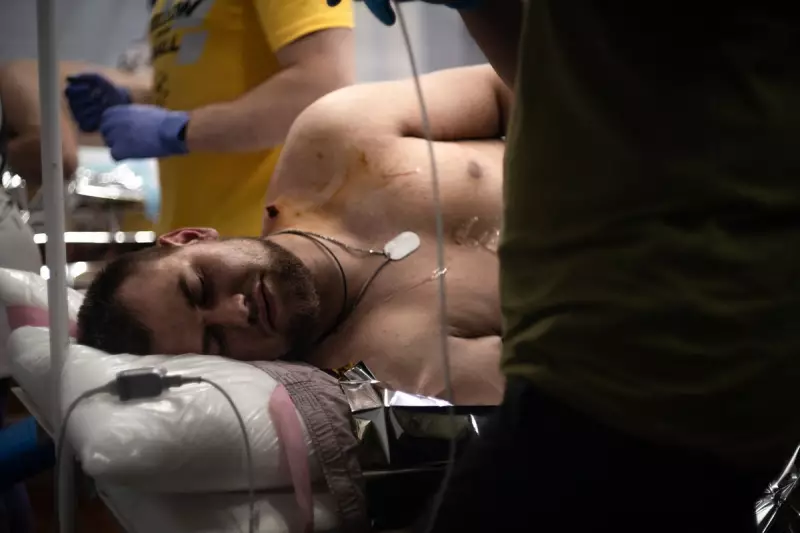
NATO Training Stuck in Past as Ukraine Faces Modern Warfare 'Hell'
Ukrainian intelligence tracks a Russian Lancet drone circling ominously above Kramatorsk, poised like a predatory bird waiting to strike. On a laptop screen, multiscreen displays show the brutal reality of contemporary combat: medics racing through devastated forests, Russian soldiers in Ukrainian crosshairs, and bunkers being systematically destroyed.
This represents the terrifying future of warfare - and according to frontline veterans, Western military alliances are dangerously unprepared for potential open conflict with Russia. The scenes depict a transformation of battle beyond anything NATO armies currently train for, featuring mass casualties and technological advancements that have rendered traditional tactics obsolete.
The American Medic's Chilling Assessment
Rebekah Maciorowski, an American volunteer paramedic coordinating medical operations, evacuation, and training for an entire battalion in Ukraine's 3rd Brigade, offers a sobering perspective. Having spent over 40 months in the conflict zone, with the rare distinction of shooting down an incoming Russian drone attacking her patients, her insights carry significant weight.
When asked if NATO is prepared for potential war with Russia, her response is unequivocal: "No. No, I'm honestly a little bit terrified."
She elaborates: "If you were to talk to NATO military officials, they would reassure you that everything is under control, they're well equipped, they're well prepared. But I don't think anyone can be prepared for a conflict like this. I don't think anyone can."
Maciorowski, who has undergone recent NATO training, reports that the instruction remained relevant to conflicts in Afghanistan and Iraq rather than addressing the realities of warfare in Ukraine. "When I went to train with NATO, the factor of drones was not really filtered in," she reveals. "It was very much the tactics that were learnt in the previous war. And these tactics now do not apply."
The Drone Revolution Changing Warfare
The advent of small, deadly drones - often flown with first-person vision and capable of pinpoint accuracy far beyond traditional front lines - has fundamentally transformed conflict. Oleksandr Yabchanka, commander of a drone unit in the Da Vinci Wolves battalion, confirms that both sides are rapidly adapting to this new reality.
"We are changing the structure of the war on the go," says Yabchanka. "There is bad news for Ukraine and Europe. Russia is adapting just like us. It is a colossal threat and very underestimated in Europe."
According to recent analysis by Jack Watling of the Royal United Services Institute, NATO doctrine focusing on "combined arms manoeuvre" - concentrating aircraft, armour, infantry and artillery to surprise and overwhelm enemies - no longer functions effectively. Modern surveillance creates near-total battlefield transparency, making surprise attacks almost impossible, while precision weapons make concentrated forces vulnerable to rapid destruction.
The consequences are stark: front lines have become wide, deep, shattered landscapes almost empty of infantry, with small groups of soldiers covertly moving between positions while trying to avoid drone detection.
Medical Realities and Mass Casualty Concerns
The transformation extends to medical evacuation and treatment, where traditional methods have become obsolete. Maciorowski's teams now evacuate wounded soldiers using quad bikes because armoured ambulances have become "death traps" in the drone-dominated environment.
Yet even these adaptations come at a heavy cost. Recently, a top medic known as Viking was killed during a rescue mission east of Slaviansk, while another driver was blown up by a drone just weeks earlier.
Maciorowski describes the changing nature of combat injuries: "The wounds, the injuries, are catastrophic. And they're multiplying because the radius of impact for a drone that drops a grenade or explosive device is massive. So you can have an entire group that's taken out, all of them injured in one drop."
This requires a fundamental shift in medical preparedness, with every soldier needing advanced medical training to treat themselves and others during prolonged periods without evacuation. Gangrene has become commonplace among Ukrainian soldiers stuck on front lines for extended durations.
Ed Arnold, a former British Army officer now with RUSI, emphasises the scale of the challenge: "We almost can't comprehend the scale of those losses" that NATO would face in similar conflict. Britain's largest mobile field hospital capacity of 80 general beds and 10 intensive care beds would be completely inadequate for the hundreds of daily casualties experienced in Ukraine-style warfare.
While a British-led programme called Operation Interflex has trained 61,000 Ukrainian soldiers, with officials reporting that 91% feel more confident about survivability after training, veterans argue that the knowledge transfer should flow both ways.
Arnold advocates for immediate changes: "We should have Ukrainians training [British officers] at Sandhurst at the moment. There should be a resident Ukrainian platoon, which regularly rotates, giving us the actual download on what's going on."
As Russian forces concentrate approximately 150,000 troops near Pokrovsk in what Ukrainian officers describe as "hell" conditions, the urgent need for Western military adaptation becomes increasingly apparent. With Vladimir Putin having expressed ambitions toward Baltic states and eastern European countries formerly under Moscow's influence, the lessons from Ukraine's battlefields may prove crucial for European security in the coming years.





